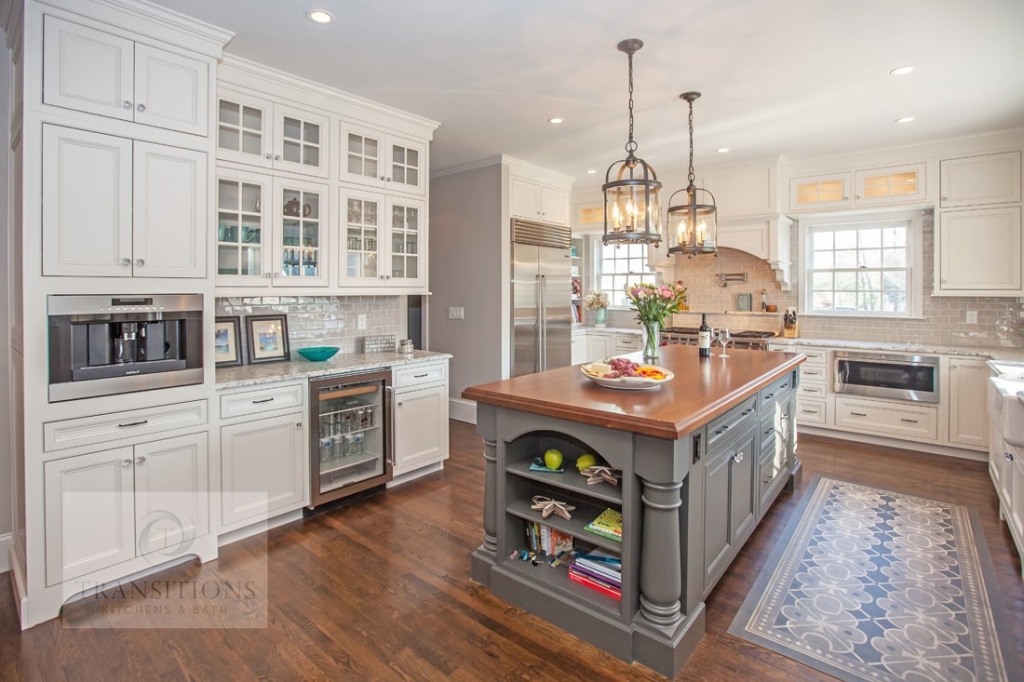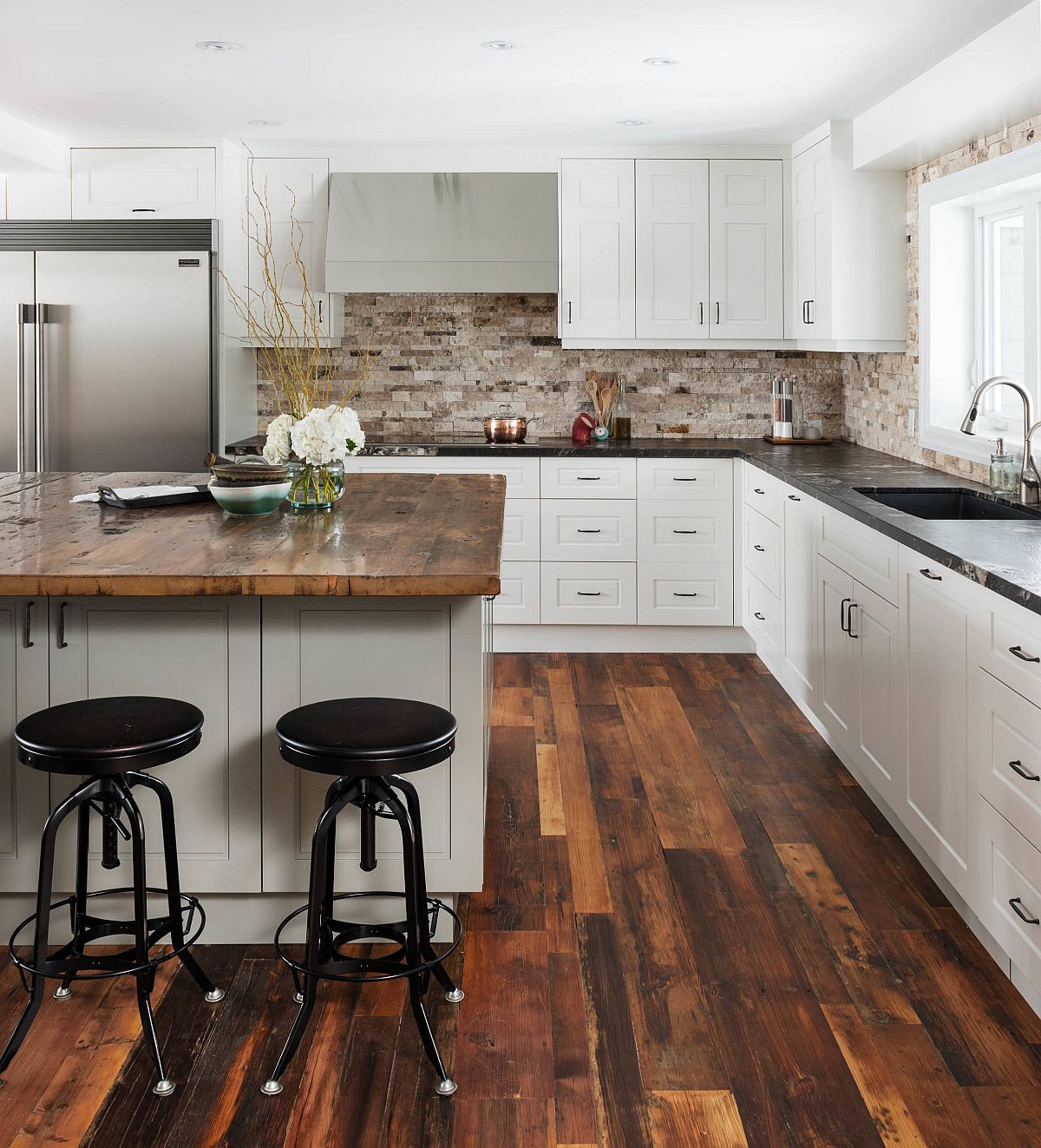The heart of a home, the kitchen is a space where families gather, meals are prepared, and memories are made. With so much activity, creating a harmonious and inviting atmosphere is essential. When choosing materials for your kitchen, the flooring and cabinetry play a crucial role in setting the tone and aesthetic. Many homeowners opt for wood, a timeless classic that exudes warmth and elegance, but coordinating wood floors with wood cabinets can seem like a daunting task. This article delves into the nuances of this design choice, exploring the principles of color matching, grain patterns, and style considerations that will ensure a cohesive and stunning kitchen space.

Image: dragon-upd.com
Wood flooring and cabinets, when wisely coordinated, effortlessly enhance your kitchen’s character and lend a touch of sophistication. You might be surprised to discover that successful coordination goes beyond simply matching colors; it encompasses understanding the subtle interplay of wood tones, grain patterns, and overall design style. Let’s embark on a journey to discover the secrets of achieving kitchen harmony with wood flooring and cabinets.
Understanding the Foundation: The Role of Wood Flooring
Setting the Stage with Warmth and Texture
Wood flooring serves as the foundation of your kitchen’s design, influencing the overall feel and visual appeal. It’s more than just a surface; it acts as a canvas upon which your chosen cabinets will stand. Choosing the right wood flooring can dramatically impact the success of your kitchen coordination plan.
Wood Species and Colors: A Spectrum of Possibilities
The world of wood flooring offers a vast array of species, each possessing unique characteristics in color, grain, and durability. Oak, maple, hickory, cherry, and walnut are just a few popular choices, each bringing its own distinct personality. Oak, with its rich range of colors and grain patterns, is a perennial favorite. Maple, known for its lighter tones and tight grain, provides a clean and contemporary aesthetic. Hickory, with its distinctive graining and durability, adds character and warmth. Cherry, with its reddish-brown hues and beautiful grain, creates a sophisticated and elegant vibe. And walnut, with its dark, rich tones and intricate patterns, offers a timeless elegance.

Image: www.decoist.com
Harmonizing with Cabinets: A Symphony of Style
The Importance of Color Matching
When coordinating wood floors with cabinets, color matching is a crucial step in establishing visual harmony. You can go for a subtle contrast, where the wood floor and cabinets have similar but distinct tones, or embrace a bolder contrast, with contrasting wood tones that create a sense of dynamism. The key is to ensure that the colors complement each other, creating a visual flow that draws the eye throughout the kitchen.
Beyond Color: Grain and Texture
In addition to color, the grain patterns and textures of wood floors and cabinets also play a vital role in coordination. You can choose wood flooring and cabinets with similar grain patterns, such as a consistent linear grain or a more intricate, swirling pattern. The textures of the wood can also contribute to harmony. For example, a smooth finish on the floor can be complemented by a slightly textured finish on the cabinets, creating an interesting contrast without disrupting the visual flow.
Wood Stain Options: Fine-Tuning Your Look
Wood stains offer a wonderful way to refine the color of your wood floors and cabinets, giving you control over the overall tone and ambiance of your kitchen. Stain colors range from light and natural to rich and dark, allowing you to create a soft, earthy feel, an elegant and sophisticated look, or a dramatic and rustic ambiance.
Navigating Styles: From Rustic to Contemporary
Embracing Your Design Vision
The style of your kitchen should inform your choice of wood floor and cabinet combinations. A rustic kitchen might feature distressed wood floors and cabinets with a warm, earthy tone. A contemporary kitchen, on the other hand, could benefit from sleek, minimalist cabinets and light-toned, engineered wood floors.
Style Considerations:
For a traditional kitchen, consider using a classic wood species like oak, with a warm honey tone, for both the floors and cabinets. In a farmhouse-style kitchen, opt for reclaimed wood floors with a slightly weathered appearance and cabinets painted in a crisp white or cream color. For a modern kitchen, consider white cabinets with dark, engineered wood floors or sleek, grey cabinets with cool, light-toned engineered wood floors.
Tips for Successful Coordination:
Choosing the right wood flooring and cabinets to go together can seem overwhelming at first. Here are some helpful tips to guide you:
- Create a Mood Board: Gather samples of wood flooring and cabinetry that catch your eye, and create a mood board to visualize how they will work together in your kitchen. This will help you see if the colors, grains, and textures complement each other.
- Consider the Natural Light: Assess the amount of natural light your kitchen receives. Lighter wood combinations often work best in kitchens with ample natural light, while darker wood combinations can provide warmth and coziness in a kitchen with less natural light.
- Think about the Overall Design: Consider the style of your kitchen, the overall color scheme, and your personal preferences. A rustic kitchen might benefit from a distressed wood floor and cabinets with a natural finish, while a modern kitchen might call for a sleek, engineered wood floor and minimalist cabinets.
- Don’t Be Afraid to Mix and Match: You can achieve a beautiful and unique look by mixing and matching different wood species, stains, and finishes. For instance, light oak flooring can be paired with a dark walnut countertop, creating a visually compelling contrast.
- Seek Professional Guidance: Consultation with an interior designer or kitchen remodeler may be well worth the investment, as they can offer valuable insights and help you choose the right flooring and cabinets for your specific kitchen and style preferences.
Remember, coordinating wood floors and cabinets involves more than just choosing colors; it’s about creating a harmonious and visually appealing space that reflects your personal style.
Kitchen Coordinating Wood Floor With Wood Cabinets
Conclusion
Creating a cohesive and stylish kitchen with wood flooring and wood cabinets is a rewarding endeavor that can transform your home’s central space. By understanding the factors that influence color matching, grain patterns, and overall design style, you can assemble a kitchen that radiates warmth, elegance, and a touch of timelessness. Whether you prefer a classic, rustic, or modern aesthetic, the right combination of wood floor and cabinet choices will help you achieve a kitchen that is truly unique and reflects your own personality and taste.





